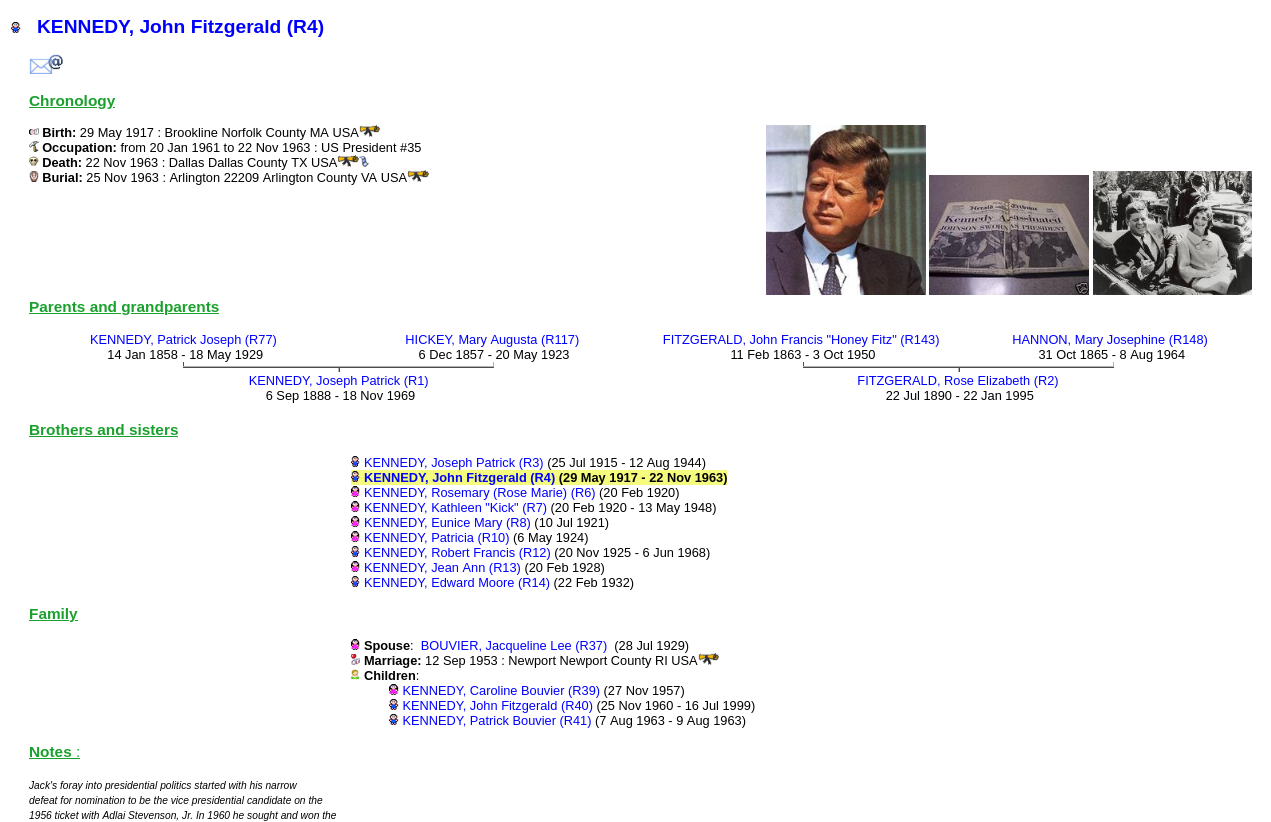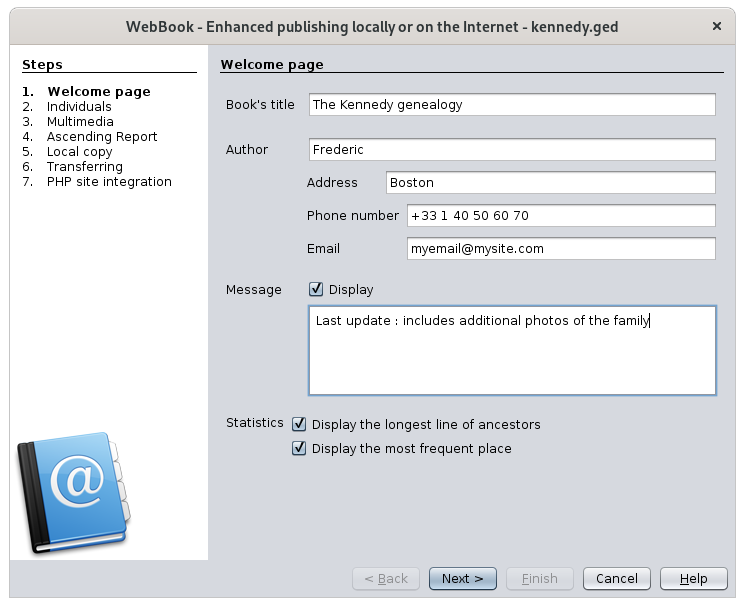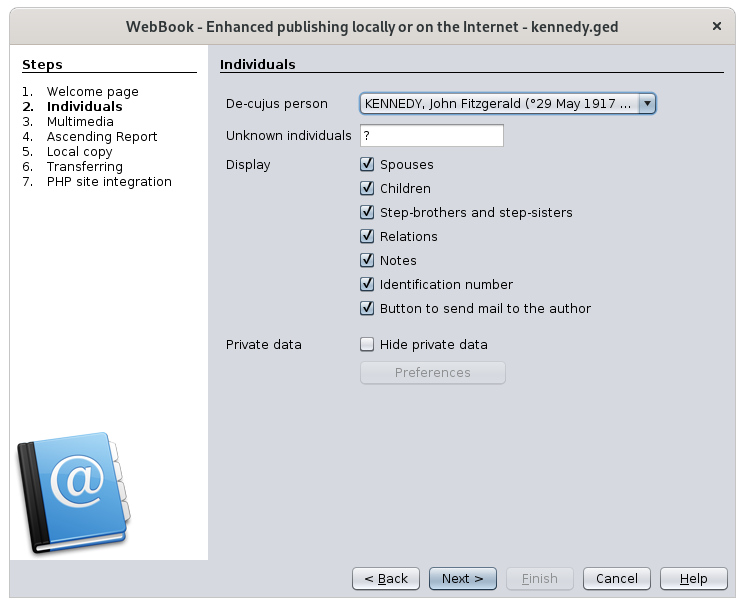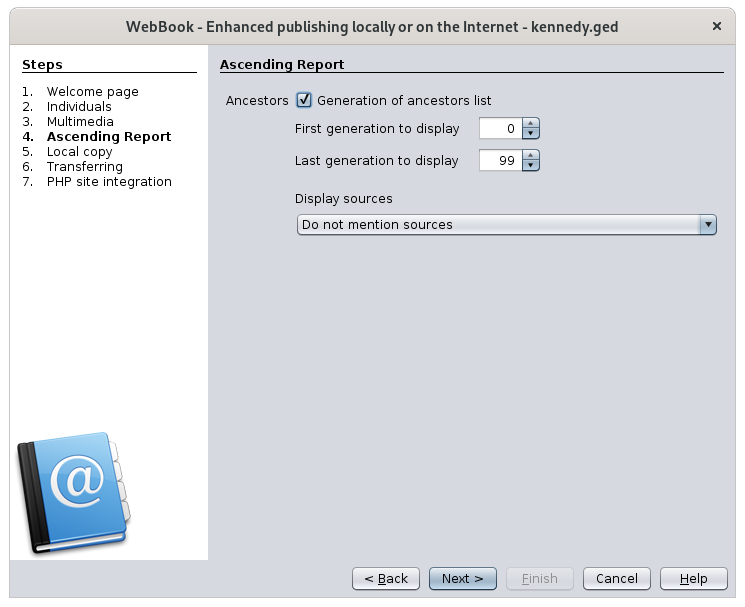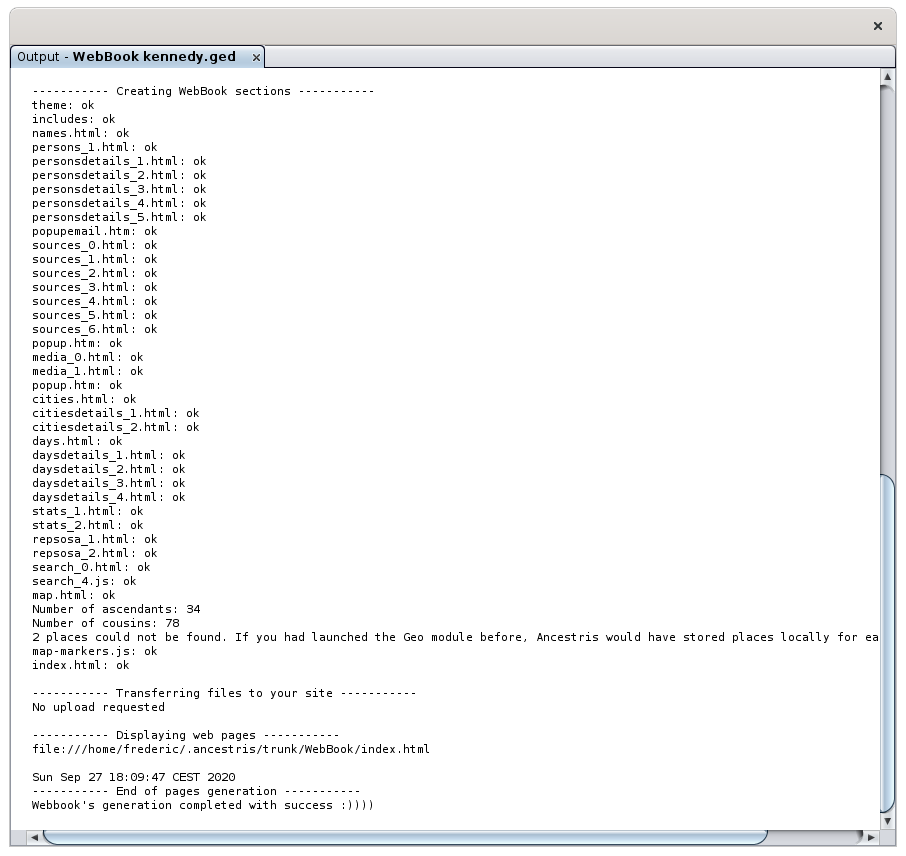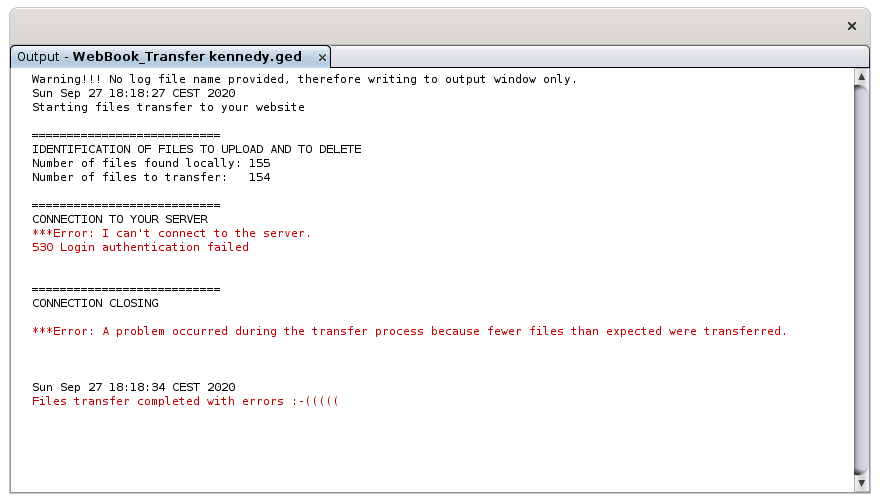Web book (L)
The Web Book or WebBook,book makes it possible to generate Web pages, from a genealogy file to be placed locally, on a private CDusb key to share with relatives, or on a public Internet site.
Comment from a user:
This little book is really convenient, pleasant to use and complete enough to go through one's genealogy.
I may not know how to use other genealogy software correctly, but when I made an web export with them, I found the result harsh and less intuitive.
If you don'tdo not want to put your genealogy tree online,and data on a web site, no problem, you can just make a local copy on any support (hard disk, USB key...) and consult it with anany internet browser (Firefox for example) or a file manager with a browser (Konqueror for example).browser.
Description
The previous image is an example in French of the Web Book with the BourbonKennedy family tree.
OneAn extract of the detailIndividuals details pages looks like this:
For an example in English, you will find a Web Book with the family tree of John Fitzgerald Kennedy.
The WebBook works with the Map View if you want to generate a map.
Navigation in the generated pages
The various pages generated formconstitute the sections of a "web book". The followingMany sections are accessible from the home page.page and part of the content can be customized.
Surnames:Lastnames: This section lists the surnames and their frequency of appearance in the family tree.
ListIndividuals of individuals:list: This section lists all the individuals in the tree in alphabetical order.
Individuals details : This section gives a detailed description of all the individuals. For each individual, there are details about birth, marriage and other events. Details also include grandparents, parents, half-brothers and half-sisters, marriages, children, relationships (godparents, godmother, witnesses, etc.), and notes. This section also displays up to five photos or media related to each individual or their wedding(marriage(s). For each event a source icon allows you to see if a source exists. Simply click on the icon to see it. The images and media of the sources are not displayed in this section but in the sources section.
Sources:Sources: The first page of this section displays the list of all the sources of the gedcom file.genealogy. The following pages give the details of each source. The source details include, where available, the text of the source and the images and media of the source and associated individuals and families. If the media is not an image (.gif, .png, .jpg) then the document is considered to be of a different nature and an image representing a media file is displayed. Clicking on the image brings up the source document in its original size or launches the media (sound, video, etc).
Photos and other media:media: The first page of this section displays a list of all the media in the gedcom filegenealogy that are associated with individuals and families. The following pages give the images of these media in the form of a photo album. This section does not contain the source material. If the media is not an image (.gif, .png, .jpg) then the document is considered to be of another nature and an image representing a multimedia file is displayed. Clicking on the image brings up the source document in its original size or launches the media (sound, video, etc). If the media is not found, an image indicates this, allowing you to rectify your Gedcom filegenealogy if necessary.
GeographicGeo Map:map: This section displays a geographic map with the location of all the cities identified in the family tree. This map is interactive and you can zoom in, show ancestors or cousins, birth, marriage or death, or events between two given years. By clicking on a city, you will see the main information about the events that took place there. These maps only work if the coordinates of the locations exist and are correct. For this, it is recommended to installcheck the geographicGeographic locationmap module.view.
ListCities of places:list: This section gives the list of cities where at least one event in the family tree took place.
LocationCities details:details: This section details for each location all the events that took place there. If you have generated the map, a small icon may show you the location of the city on the map.
Family Calendar:Calendar: This section lists the days of the year when at least one event in the family tree took place.
Calendar Details:Details: This section details for each day of the year all the events that took place there.
Patronymics, places and most frequent days Statistics: This section presents the frequency of surnames, places and days of the year, from the most to the least frequent.
ImplexeInbreeding and inbreeding:degree: This section presents the inbreeding ratio of the selected main individual.
Ancestors List:List: This section presents the ancestors of the selected main individual. The ancestors are displayed in ascending order of sosaSosa number.number.
Individuals search:search: This section is a tool to search for individuals in your family tree using a set of criteria.
Web book generation wizard
The wizard presentsassists successivelyyou to customize the pages of the Web book through 7 followingpanels. screensAt andthe thenend, it shows you the detailed log of the generation.
Content of the homeWelcome page
TheseThis optionspanel allow you to customizecustomizes the homeWelcome page of your family tree book.
Hovering over a field displays a tooltip explaining its function.role.
WebBook'sBooktitle:Title: Thisthis is the title of your Genealogy book. It appears on the home page and in the title bar of thenavigation window.browser.Author:Author: This is the name of the author of your Genealogy.Address:Address: This is the address of the author.- Phone
ornumberother&contact (ex: Mail, etc.)Email: This is the contact information of the author. - Message: check the box and write a message to display it at the beginning of the home page.
- Display the longest
ancestorlineline?of ancestors: Select this option if you want to display information about the longest ancestor line in your Genealogy. Jurisdiction level forDisplay the most frequentlocation?place:ThisSelectnumberthisindicatesoption to display this statistic on thelevelhomeof jurisdiction to be used to calculate the most frequent place in the tree. This level corresponds to the "place" format of the gedcom file, where '0' indicates the lowest level.page.
Individus à afficherIndividuals
-
TheDeCujuschoice of the individual of the decedent (main individual).person: This individual will be accessible from the home page, and it is from him that the ancestor report will be indicated. -
Unknown individuals: This is used to designate a person whose first and last names are unknown (example: you can put the word "unknown" in this field).
-
Spouses display : Select this option if you want to display the spouses.
-
Display children : Select this option if you want to display the children in the families.
-
Display half-brothers and half-sisters: Select this option if you want to display half-brothers and half-sisters. These are referred to in the Descendants, as uterin/consanguineous siblings.
-
Show Relationships: Select this option if you wish to display the relationships that link individuals together (i.e. whether a person has been a witness at a wedding for example, godparents, etc.).
-
Display notes : Select this option if you wish to view the notes associated with individuals and families.
-
Display ID Numbers: Select this option if you want Ancestris ID numbers to be added after the person's name.
-
Display email sending: Select this option if you want to display a "send email" icon so that the user can easily send an email to the author about an individual.
You can then choose to hide the private data and redefine it using the Preferences button. This button will open the Ancestris preferences window.
-
On a PHP site, private data will be hidden and visible only by using a password.
-
On an html site that is static, private information is not generated
Multimedia to display
Sources
- Source section generation: Select this option if you want to generate the source section.
- Display source images: Use this drop-down menu if you want to display the documents related to the sources. You can display or not the source links of the associated entities, with a simple text link or a thumbnail image reminding the source.
- Local copy of originals: Select this option if you want to copy the original documents to your website. Otherwise, link files are used. It is recommended not to select this option if the total size of your documents is large. If you later want to have these documents on your website, you can always replace the link files with smaller files using the copy function of your system.
Media
- Generate Photo Section: Select this option if you want to generate the media section.
- Local copy of originals: Select this option if you want to copy the original documents to your website. Otherwise, link files are used. This option is similar to the source option described above.
Map
- Map generation: Select this option if you want to generate the interactive map.
- Display of places not found: Select this option if you want to display markers for cities whose coordinates were not found. Markers will appear in the middle of the Atlantic Ocean
Addition of the ascending report
- Generate Ancestor List: Select this option if you want to generate the ancestor list. In this case you will be asked for the following options when generating this section
- First generation to display : Ancestors will only be displayed from the indicated generation on.
- Latest generation to display : Ancestors will only be displayed until the indicated generation.
- Display sources: Choose if and how to display the sources. Use the menu to specify how the sources should be displayed.
Local publishing
- Local Web Book Backup: Specify the directory where the Web Book will be located on your disk. It is this directory that you will consult locally with an internet browser (Firefox for example) or a file manager with a browser (Konqueror for example) if you do not want to trace your genealogy on your website.
Watch out! This directory must be empty, otherwise the documents it contains will be deleted.
- Saving the generation log of the book: Indicate the directory where the generation log will be located which contains the scroll and possible errors.
Possible transfer over the Internet - optional
If you only want to generate the pages locally, uncheck the first box and simply click next.
- Move up the pages on the site: Select this option if you want to move up the pages on a website of your choice. You will need to provide additional information to enable such a page lift. These are the following options. If you choose to bring up the pages on a website, the report will ask you to fill in the name of a log file. This file will contain a complete list of the uploaded files.
- Website FTP address: Address of your FTP site. Ex: ftp.nom2monsite.monfournisseur.fr
- Root directory for your pages on the site: This is the target directory where the pages must be uploaded. ex: /directory/
- FTP user name: the name to be used for access to the FTP site, it is the name that identifies you on the site.
- Password to be used to access the FTP site: This is the password to access the site.
- Description of the website : The sentence you will put here will appear in the headers of the html pages created as "meta name - Description". This element is important, because robots, search engines, will examine these parts of your files.
- Type of transfer: This option allows you to improve the efficiency of the pages on your site. For example, if a photo of an ancestor is generated in the Web Book but it is identical to the one previously uploaded, there is no need to upload it again.
- Three options are possible: transfer all locally generated files to the server, even if they have not changed; transfer only those that have changed; or transfer those that have changed and also delete from the server those that are no longer generated.
- Reset Upload History: Select this option to restart file transfers from the beginning. This will mean that all files will be systematically uploaded the next time they are transferred. The registry retains the details of the previous uploads and therefore allows you to determine which of the newly generated files need to be uploaded again. As long as you only use the WebBook to roll up your pages, you should not need to reset the registry. However, if you sometimes use another FTP client, this registry may need to be completely refreshed, which is done by checking this option.
- Program to launch at the end of the Web Book generation: Specify here the name of the program to launch at the end of the Web Book generation. If the first character is '0' then this option is ignored. Launching a program at the end can be useful if there are still other things to do on your site to finalize its update.
- Backup of the upload log: Specify here the directory where the upload log should be saved. This log shows you the details of the uploaded pages.
Possible integration to a PHP site - optional
If you only want to generate the pages locally, uncheck the first box and simply click next.
This part is technical and requires to know the principles of a PHP site including very precise page structures.
- PHP site: Check this box if your site is written in PHP
- Profile Codes and Code are the usernames and passwords used to view private information.
- Existing site : Check this box if the genealogical pages are integrated in a larger site, and must then respect the same headers and footers for example
- Private data: Indicate here the name of the function that will test the codes for private data.
- Scripts: Indicate here the PHP scripts corresponding to the different components of your PHP website
Result of the generation
Ancestris displays the Output windows at the end of generation, where you can see each of the two logs: generation and transfer if applicable.
Here you have an example of generation that went well.
Result of the transfer
Here you have an example of a transfer that went wrong.
Additional information
- Private information is managed using the Ancestris options. If an individual is considered private according to the Ancestris options, the web book will display "..." instead of the plain text details.
- The Sosa numbering is taken into account if the labels "_SOSA" are present in the gedcom file. This label can be generated using the "Toolbox" report. Be sure to run both reports (Toolbox and Web book) with the same "first" individual.
- If the local directory in which the pages will be generated is not empty, a message tells you so. This message appears in the Ancestris window for running the report.
The generated html pages are W3C XHTML 1.0 certified. - Special characters are replaced in the pages by the equivalent html sequence (example: "é" is replaced by "é")
- In order to optimize performance, media and source files are not copied (or linked) if they already exist in the target directory. To force this copy (or these links), just delete the files in the target directory.
- A feature makes it easy for the website user to send email to the author
- An intelligent page rollup feature saves a considerable amount of time by only rolling up files whose content has changed. This works very well as long as the WebBook is the program used to pull up the pages because it keeps the details of the files transferred each time.


